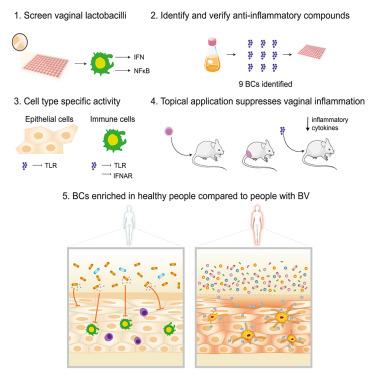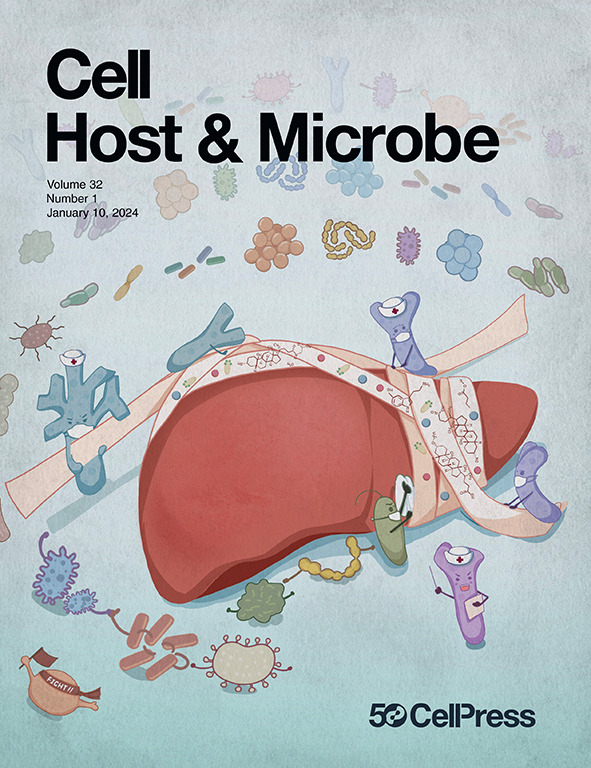Vaginal lactobacilli produce anti-inflammatory β-carboline compounds
IF 20.6
1区 医学
Q1 MICROBIOLOGY
引用次数: 0
Abstract
The optimal vaginal microbiome is a Lactobacillus-dominant community. Apart from Lactobacillus iners, the presence of Lactobacillus species is associated with reduced vaginal inflammation and reduced levels of pro-inflammatory cytokines. Loss of Lactobacillus-dominance is associated with inflammatory conditions, such as bacterial vaginosis (BV). We have identified that Lactobacillus crispatus, a key vaginal bacterial species, produces a family of β-carboline compounds with anti-inflammatory activity. These compounds suppress nuclear factor κB (NF-κB) and interferon (IFN) signaling downstream of multiple pattern recognition receptors in primary human cells and significantly dampen type I IFN receptor (IFNAR) activation in monocytes. Topical application of an anti-inflammatory β-carboline compound, perlolyrine, was sufficient to significantly reduce vaginal inflammation in a mouse model of genital herpes infection. These compounds are enriched in cervicovaginal lavage (CVL) of healthy people compared with people with BV. This study identifies a family of compounds by which vaginal lactobacilli mediate host immune homeostasis and highlights a potential therapeutic avenue for vaginal inflammation.

阴道乳酸菌产生抗炎的β-咔啉化合物
最佳的阴道微生物群落是以乳酸杆菌为主的群落。除乳酸杆菌茵外,乳酸杆菌的存在还与阴道炎症的减少和促炎症细胞因子水平的降低有关。乳酸杆菌优势的丧失与炎症有关,如细菌性阴道病(BV)。我们发现,脆片乳杆菌是一种重要的阴道细菌,它能产生一系列具有抗炎活性的β-咔啉化合物。这些化合物能抑制原代人体细胞中多种模式识别受体下游的核因子κB(NF-κB)和干扰素(IFN)信号传导,并能显著抑制单核细胞中 IFN 受体(IFNAR)的活化。在生殖器疱疹感染的小鼠模型中,局部应用抗炎的β-咔啉化合物perlolyrine足以显著减轻阴道炎症。与 BV 患者相比,健康人的宫颈阴道灌洗液(CVL)中富含这些化合物。这项研究确定了阴道乳酸杆菌介导宿主免疫平衡的化合物家族,并强调了治疗阴道炎症的潜在途径。
本文章由计算机程序翻译,如有差异,请以英文原文为准。
求助全文
约1分钟内获得全文
求助全文
来源期刊

Cell host & microbe
生物-微生物学
CiteScore
45.10
自引率
1.70%
发文量
201
审稿时长
4-8 weeks
期刊介绍:
Cell Host & Microbe is a scientific journal that was launched in March 2007. The journal aims to provide a platform for scientists to exchange ideas and concepts related to the study of microbes and their interaction with host organisms at a molecular, cellular, and immune level. It publishes novel findings on a wide range of microorganisms including bacteria, fungi, parasites, and viruses. The journal focuses on the interface between the microbe and its host, whether the host is a vertebrate, invertebrate, or plant, and whether the microbe is pathogenic, non-pathogenic, or commensal. The integrated study of microbes and their interactions with each other, their host, and the cellular environment they inhabit is a unifying theme of the journal. The published work in Cell Host & Microbe is expected to be of exceptional significance within its field and also of interest to researchers in other areas. In addition to primary research articles, the journal features expert analysis, commentary, and reviews on current topics of interest in the field.
 求助内容:
求助内容: 应助结果提醒方式:
应助结果提醒方式:


